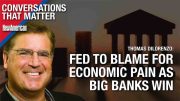
Gita Gopinath, chief economist for the International Monetary Fund (IMF), said during a press conference during this week’s annual meeting of the IMF and the World Bank in Washington that the robust recovery of the U.S. economy has forced the group to make a “significant upgrade” to its forecast for 2020.
She said:
We’re seeing a fairly quick recovery, which is why we have [made] the upgrades. In the second quarter, the recovery came about sooner than we expected.
And then, continuing into quarter three, the indicators have been [even] stronger.
Back in June she was much less sanguine that the U.S. economy would rebound so quickly, predicting at the time that, for the year, the U.S. economy would contract by eight percent. The upward revision brings that number down to half that, a little over four percent. She said:
At the time, we were thinking that the increase in the number of infections [from COVID-19] could imply some decline in mobility and activity, but that has really not materialized during the third quarter.
And that has been one of the factors explaining our upward revision.
According to the “nowcast” GDPNow model from the Federal Reserve Bank of Atlanta, the economy is likely to show an annualized growth of more than 35 percent when it is reported by the Commerce Department just days before the election.
Included in that forecast is that real gross private domestic growth — the oil and gas that fuels the economy — will show an annualized gain of nearly 50 percent in the third quarter.
St. Louis Federal Reserve President James Bullard concurs, predicting “off the charts” growth when the final numbers are in for the third quarter.
Richard Moody, chief economist for Regions Financial Corporation, predicts annualized growth in real (inflation-adjusted) GDP coming in at more than 30 percent.
There are other factors favoring President Donald Trump’s reelection, including nearly a century’s worth of election-year data. Since 1928, whenever the S&P 500 Index (SPX) has risen in the three months prior to a presidential election, the incumbent has won 90 percent of the time.
Three months before November 3, that index was at 3,271. Presently, it is trading at close to 3,500, a gain of more than 6.5 percent.
There’s the Gallup Poll that reported that “a clear majority of registered voters (56%) [are] saying they are better off now than they were four years ago.” This compares to Obama’s 45 percent in 2012, George Bush’s 47 percent in 2004, and Ronald Reagan’s 44 percent in 1984.
Speaking of Ronald Reagan, it is helpful to remember that in mid-October 1980, he was trailing Jimmy Carter in the polls by as much as eight points. And yet, when the dust settled, Reagan beat Carter in a landslide with 50.7 percent of the popular vote and 489 electoral college votes (to Carter’s 49), carrying 44 states (to Carter’s six, plus D.C.).
It’s also worth remembering that Reagan, then 69, was the oldest person ever to be elected to a first term until Donald Trump was elected president in 2016 at the age of 70.
Related article:



